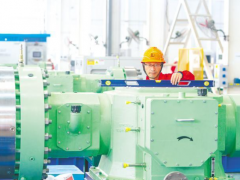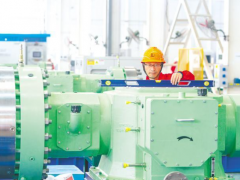据美国钻井网站报道,氢气在世界能源系统的脱碳过程中起着至关重要的作用,但氢气摄取速度太慢。独立能源咨询和认证机构挪威船级社DNV在6月14日发表的一份最新报告称,各国政府需要采取紧急、重大的政策干预措施。
DNV在题为《2050年氢气预测》报告中预测,2030年氢气在能源结构中的占比仅为0.5%,到2050年将占5%。 然而,要实现《巴黎协定》的目标,到本世纪中叶,氢气摄取量需要增加两倍,才能满足15%的能源需求。
DNV集团总裁兼首席执行官埃里克森表示:“对于航空、航海和高温制造业等无法电气化的行业来说,氢气是必不可少的,因此应该优先考虑这些行业。” “现行政策与氢气的重要性不符。他们还需要支持可再生能源发电和碳捕获和存储的规模,这是生产低碳氢气的关键要素。”
根据《2050年氢气预测》,到本世纪中叶,以电力为基础的绿色氢气(利用电解槽将氢从水中分离出来)将成为主要的生产形式,占总产量的72%。这将需要过剩的可再生电力来驱动一个容量为3100吉瓦的电解槽。这是目前太阳能和风能总装机容量的两倍多。
蓝氢是一种从天然气中提取并捕获碳排放的物质,它在短期内将发挥更大的作用(到2030年约占总产量的30%),但由于可再生能源产能的增加和价格的下降,其竞争力将下降。
根据DNV的预测,从现在到2050年,全球用于能源目的的氢气生产支出将达到6.8万亿美元,另外还有1800亿美元用于氢气管道,5300亿美元用于建造和运营氨气终端。
考虑到成本因素,全球超过50%的氢气管道将从天然气管道改造而来,因为改造管道的成本预计仅占新建设成本的10%~35%。 氢气将通过管道在国内和国家之间进行中等距离输送,但在各大陆之间穿行仍为难题。全球氢气贸易也将受到船舶运输液化氢气的高成本和氢气能量密度低特性的限制。氢气的衍生物氨气能够更稳定,可以更容易通过船舶运输,将在全球进行交易。
早期氢气的摄取将由难以减弱的高温生产过程主导,例如目前使用煤和天然气的钢铁生产。氨气和甲醇等氢气衍生物是船舶和航空等重型运输工具脱碳的关键,但根据DNV的预测,这些燃料要到21世纪30年代才会规模化。
氢气不会在乘用车上得到普及,在发电上的普及也很有限。用于建筑物供暖的氢气不会在全球范围内普及,但会在一些已经拥有广泛天然气基础设施的地区看到早期的普及。
“扩大氢价值链将需要管理安全风险和公众接受度,以及就业政策,以使氢气项目具有竞争力和可获利。我们需要在能源系统层面进行规划,使社会能够拥抱氢气带来的紧急脱碳机会。”埃里克森补充说。
不同地区对氢气的摄取有很大差异,政策影响很大。到2050年,欧洲将率先实现氢气在能源结构中的占比达到11%,因为相关政策既启动了氢气生产的规模,又刺激了终端使用。
经合组织太平洋地区(2050年氢能源占能源结构的8%)和北美地区(7%)也有推动供应端的战略、目标和资金,但碳价格较低,具体目标和政策较少。大中华区(6%)紧随其后,最近对到 2035年的资金和氢气前景做出了更清晰的说明,同时扩大了全国排放交易计划。到2050年,这四个地区总共将消耗全球用于能源目的氢气需求的三分之二。
李峻 编译自 美国钻井网站
原文如下:
Hydrogen Could Be A Missed Opportunity Of The Energy Transition
Hydrogen has a crucial role in decarbonizing the world’s energy system, but uptake will be too slow. Governments need to make urgent, significant policy interventions, according to a new report by DNV.
In Hydrogen Forecast to 2050, DNV predicts the amount of hydrogen in the energy mix will be only 0.5% in 2030 and 5% in 2050. However, to meet the targets of the Paris Agreement, hydrogen uptake would need to triple to meet 15% of energy demand by mid-century.
“Hydrogen is essential to decarbonize sectors that cannot be electrified, like aviation, maritime, and high-heat manufacturing, and should therefore be prioritized for these sectors,” said Remi Eriksen, Group President and CEO of DNV. “Policies do not match hydrogen’s importance. They will also need to support the scaling of renewable energy generation and carbon capture and storage as crucial elements in producing low-carbon hydrogen.”
According to Hydrogen Forecast by 2050, electricity-based green hydrogen – produced by splitting hydrogen from water using electrolyzers – will be the dominant form of production by the middle of the century, accounting for 72% of output. This will require a surplus of renewable energy, to power an electrolyzer capacity of 3,100 gigawatts. This is more than twice the total installed generation capacity of solar and wind today.
Blue hydrogen – produced from natural gas with emissions captured – has a greater role to play in the shorter term (around 30% of total production in 2030), but its competitiveness will reduce as renewable energy capacity increases and prices drop.
Global spending on producing hydrogen for energy purposes from now until 2050 will be $6.8 trillion, with an additional $180 billion spent on hydrogen pipelines and $530 billion on building and operating ammonia terminals, according to DNV’s forecasts.
Cost considerations will lead to more than 50% of hydrogen pipelines globally being repurposed from natural gas pipelines, as the cost to repurpose pipelines is expected to be just 10-35% of new construction costs. Hydrogen will be transported by pipelines up to medium distances within and between countries, but not between continents. Global hydrogen trade will also be limited by the high cost of liquefying hydrogen for ship transport and the low energy density of hydrogen. The hydrogen derivative ammonia, which is more stable and can be more readily transported by ship, will be traded globally.
Early uptake of hydrogen will be led by hard-to-abate, high-heat manufacturing processes such as iron and steel production which currently use coal and natural gas. Hydrogen derivatives, such as ammonia and methanol, are key to decarbonizing heavy transport like shipping and aviation, but these fuels won’t scale until the 2030s according to DNV’s forecasts.
Hydrogen will not see an uptake in passenger vehicles, and only limited uptake in power generation. Hydrogen for heating buildings will not scale globally but will see early uptake in some regions that already have an extensive gas infrastructure.
“Scaling hydrogen value chains will require managing safety risk and public acceptance, as well as employment policies to make hydrogen projects competitive and bankable. We need to plan at the level of energy systems, enabling societies to embrace the urgent decarbonization opportunities presented by hydrogen,” added Eriksen.
The uptake of hydrogen will differ significantly by region, heavily influenced by policy. Europe is the forerunner with hydrogen set to take 11% of the energy mix by 2050, as enabling policies both kickstart the scaling of hydrogen production and stimulate end-use.
OECD Pacific (hydrogen 8% of the energy mix in 2050) and North America (7%) regions also have strategies, targets, and funding pushing the supply-side, but have lower carbon prices and less concrete targets and policies. Greater China (6%) follows on, recently providing more clarity on funding and hydrogen prospects towards 2035, coupled with an expanding national emissions trading scheme. These four regions will together consume two-thirds of global hydrogen demand for energy purposes by 2050.
免责声明:本网转载自其它媒体的文章及图片,目的在于弘扬石化精神,传递更多石化信息,宣传国家石化产业政策,展示国家石化产业形象,参与国际石化产业舆论竞争,提高国际石化产业话语权,并不代表本网赞同其观点和对其真实性负责,在此我们谨向原作者和原媒体致以崇高敬意。如果您认为本站文章及图片侵犯了您的版权,请与我们联系,我们将第一时间删除。







